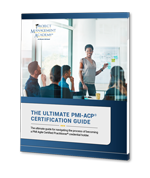On November 18th, Jeff Sutherland and Ken Schwaber released a new version of the Scrum Guide – the definitive source for Scrum. While there are a number of people who have done comprehensive reviews of the changes and debated in excruciating detail the meaning behind each of these changes (see this article by Johnannes Geske for a side-by-side comparison), that is not my intent with this commentary. Instead, I want to give you a few things that I like about the updates and a few things that will challenge most organizations as they continue to seek the most effective way to deliver value to their customers.

Download the Ultimate Guide to learning about the PMI-ACP Certification.
Let’s start with the positives:
 Simplification – The new version of Scrum has been simplified. Scrum has always been a minimal framework for building product. The most recent updates reduce it even further. For example, the three questions of the Daily Scrum are no longer mentioned. The move toward simplifying Scrum gives more freedom to the Teams practicing it.
Simplification – The new version of Scrum has been simplified. Scrum has always been a minimal framework for building product. The most recent updates reduce it even further. For example, the three questions of the Daily Scrum are no longer mentioned. The move toward simplifying Scrum gives more freedom to the Teams practicing it.- Beyond Software – This version acknowledges that Scrum has been applied beyond software. While Scrum’s roots are clearly in the software domain, it has been applied in a number of other domains. By acknowledging this, Schwaber and Sutherland tear down a common rebuttal to Scrum – “We aren’t building software, so we can’t use Scrum”.
- Key Clarifications – Schwaber and Sutherland have clarified or defined a number of key terms in this version of the Guide. Adding a definition of “Product” and placing an emphasis on “Why” in Sprint Planning can only help organizations that are new to Scrum.
In spite of these positives, there are a few things that concern me about the new version. Note that I state these as “concerns”, not “negatives”. This is important because I don’t necessarily see them as “bad”, but instead as things that may hurt an organization’s adoption of Scrum and, consequently, its ability to deliver value.
 Accountabilities vs. Roles – The Scrum Guide no longer references three roles but instead discusses three sets of “accountabilities”. Some have speculated that Schwaber and Sutherland made this change to avoid a struggle that many organizations experienced in trying to differentiate a “role” from a “title”. While that struggle was real, I fear that using “Accountabilities” will allow organizations to put all of these accountabilities on single person (e.g. “You are going to be both the Scrum Master and the Product Owner). In doing so, I fear both overwork for the person and a poorly executed adoption of the framework.
Accountabilities vs. Roles – The Scrum Guide no longer references three roles but instead discusses three sets of “accountabilities”. Some have speculated that Schwaber and Sutherland made this change to avoid a struggle that many organizations experienced in trying to differentiate a “role” from a “title”. While that struggle was real, I fear that using “Accountabilities” will allow organizations to put all of these accountabilities on single person (e.g. “You are going to be both the Scrum Master and the Product Owner). In doing so, I fear both overwork for the person and a poorly executed adoption of the framework.- Does it really matter? – While a number of trainers and coaches in the Scrum community debate the changes, I wonder, “Does it really matter?”. The objective of adopting Scrum was never to do Scrum as described in the guide. Instead, Scrum is about helping an organization develop the discipline to regularly deliver product increments that delight its customers. As Schwaber and Sutherland make clear in this update – “Scrum is still Scrum”. While it’s interesting to debate the changes, we can’t lose sight of the original goal.
What are your thoughts? Drop me a note at mike@agilityIRL.com
To learn more about Agile development, view Mike’s blog.


 New Horizons
New Horizons
 Project Management Academy
Project Management Academy
 Six Sigma Online
Six Sigma Online
 TCM Security
TCM Security
 TRACOM
TRACOM
 Velopi
Velopi
 Watermark Learning
Watermark Learning
 Login
Login




 New Horizons
New Horizons
 Project Management Academy
Project Management Academy
 Velopi
Velopi
 Six Sigma Online
Six Sigma Online
 TCM Security
TCM Security
 TRACOM
TRACOM
 Watermark Learning
Watermark Learning